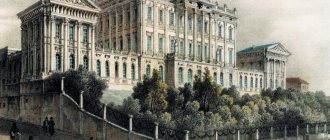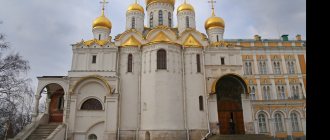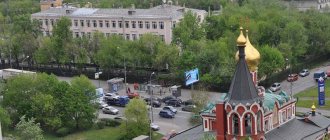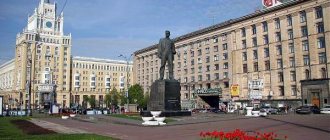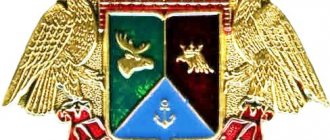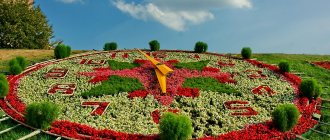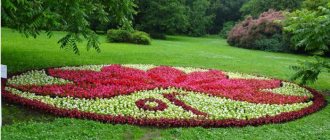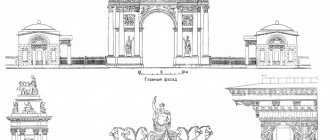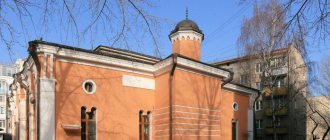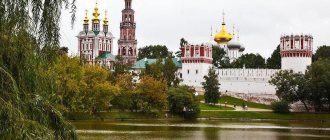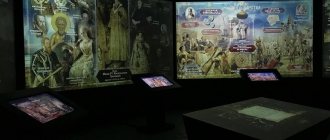One of the largest monuments in Russia is located in Moscow. This is a monument to Peter I on the Moscow River. It was built on a small artificial island between the river and the Vodootvodny Canal. The monument to Peter I in Moscow, made by Tsereteli, bears the official name “In commemoration of the 300th anniversary of the Russian fleet.” The monument is formed from 3 parts: a pedestal, a ship and an emperor.
Surrounded by much controversy over its appearance, aesthetics, size, location, and production and installation costs, the monument has earned itself a controversial reputation. After its installation, the monument to Peter the Great in Moscow was mentioned in various literary, musical and film works.
Panoramic view of the monument to Peter I in Moscow:
The legend about the appearance of the monument
Despite the fact that the monument is still quite “young”, it already has its own legend. One day, reports appeared in the Russian media that the Peter 1 monument (a monument in Moscow) was converted from a statue of the discoverer of America, Columbus. Tsereteli, the creator of this structure, was unable to sell his masterpiece to the United States, and it ended up in the hands of the Russians.
How to get to the monument to Peter I in Moscow
The monument is located in the Yakimanka district, on an island between Prechistenskaya and Krymskaya embankments, near the Muzeon art park. From the first embankment, for a closer look at the monument, you can walk along the Bolshoi Kamenny Bridge, from the second - along the Small Kamenny Bridge.
You can get to the Moscow monument to Peter I by public transport. The nearest stop from which you can go down through Muzeon close to the monument is 3rd Golutvinsky Lane . They go to her:
- Buses No. m1, n11, t7, 144.
- Trolleybuses No. m4, 4.
Then you can walk along the embankment to the Crimean Bridge, which offers a good panoramic view of the monument to Peter on the Moscow River. You can also get to the bridge by bus :
- No. B, t79, stop “Crimean Bridge” .
- No. t10, stop “Central PKiO im. Gorky" .
Moscow public transport schedule
The view of the monument from the back side opens from the Patriarchal Bridge. You can get to the monument to Peter the Great in Moscow by taxi using Yandex services. Taxi, Uber, Gett, Maxim, Taxi Lucky.
© A.Savin
Metro near the monument to Peter in Moscow
Nearest metro stations:
- Station "Park Kultury" of the Sokolnicheskaya Line - near the Krymsky Bridge from the side of Prechistenskaya Embankment.
- Oktyabrskaya station of the Kaluzhsko-Rizhskaya and Circle lines is at the Krymsky Bridge from the Krymskaya Embankment.
- On the reverse side of the monument is the Kropotkinskaya station of the Sokolnicheskaya line.
- From the street side Bolshaya Yakimanka - Polyanka station of the Serpukhovsko-Timiryazevskaya line.
Moscow metro map
Video about the monument to Peter on the Moscow River:
Description of the monument
The monument to Peter 1 on the Moscow River is a unique structure. The supporting frame of the pedestal with bronze cladding is made of stainless steel. The pedestal, the figure of the king and the ship were assembled separately. Peter and the ship were installed last. Ship shrouds are also made of stainless steel.
All of them are securely fastened with thick cables. To reduce the weight of copper sails, they have a metal frame inside them. The highest quality bronze was used to make the monument. First it was sandblasted, then platinized. Then the bronze was covered with wax and a special varnish. They protect the source material from bad weather.
The king holds a gilded scroll in his hands. St. Andrew's crosses are made in the same color. The flags on which they are located are made in the form of weather vanes. A staircase was built inside the monument, with the help of which the structure is maintained.
The artificial island on which “Peter 1” (a monument in Moscow) is installed is made of a reinforced concrete foundation. There are fountains all around that create the feeling that a ship is cutting through the waves.
Author of the monument to Peter in Moscow
The famous Russian sculptor and artist Zurab Tsereteli became the author of the monument to Peter I in Moscow. Some media outlets claim that the history of the creation of the monument to Peter I in Moscow is based on falsehood, since the sculpture is made from a sample of the monument to Columbus, authored by Zurab Tsereteli.
The sculptor subsequently faced even greater criticism of his work - the monument to Peter the Great in Moscow. First of all, dissatisfaction was expressed with the incorrect proportions: the figure of the Russian Tsar looks too large on a small ship. Residents of the city also spoke about the poorly chosen location and, in general, the too huge size of the monument. Experts pointed to a number of factual errors in the king’s uniform and ship equipment. Tsereteli and the monument to Peter in Moscow became the objects of various complaints and accusations.
© tpanova
Passion around the monument
The pedestal of the monument is decorated with rostras. Each is decorated with St. Andrew's flag. It turns out to be a contradiction that Peter the Great fought with his own fleet. The monument became tenth on the list of the ugliest pedestals in the world. This rating was published on the Internet portal “Virtual Tourist” in 2008.
In July 1997, the place where the monument to Peter 1 was erected in Moscow became famous. The Revolutionary Military Council group tried to undermine the monument. According to one version, explosives had already been planted. But due to the fact that passers-by and surrounding buildings could have been injured, the explosion was stopped by the group itself. According to another version, the bombing was foiled thanks to an anonymous call. Since then, there is no longer close access to the monument.
Characteristics
The monument to Peter I in Moscow is made of different materials: stainless steel lined with bronze of the highest quality, copper for the sails, as well as gilding for the scroll in the emperor’s hand and St. Andrew’s crosses on the flags. There are fountains around the pedestal.
The height of the monument to Peter I in Moscow exceeds the height of the Volgograd sculpture “The Motherland Calls!”
The height of the monument to Peter in Moscow is 98 meters, of which 18 meters is the figure of the emperor. In many respects, the monument is unique. It is difficult to give an exact answer to the question of how much the monument to Peter I weighs in Moscow; the total weight will be more than 2000 tons.
© Pavel Kazachkov
Modern “battle” for Peter the Great
According to information published in the printed publication Izvestia, at the Arch Moscow exhibition, which is held annually, a project appeared according to which the Peter 1 monument (a monument in Moscow) should be enclosed in a glass “package”. Moreover, such that the masterpiece could not be seen through it.
This was in 2007. The author of the project, Boris Bernasconi, proposed building a monument to Peter the Great into a skyscraper. As a result, the monument would be hidden from human eyes. Even Tsereteli would be pleased. The skyscraper would become a museum for Tsereteli’s masterpiece, and Muscovites and city guests could enjoy the new observation deck, turning it into a place for cultural recreation.
In 2010, it got to the point that it was proposed to demolish the monument to Peter 1 completely. This happened after Luzhkov’s resignation from the post of mayor of the capital. Monument to Peter 1 in Moscow, where is it located? It is installed above the waters of the Moscow River, on Krymskaya Embankment, 10. Nearby are the Park Kultury and Oktyabrskaya metro stations.
In 2010, after the proposal to demolish "Petra", the acting mayor, Vladimir Resin, seriously thought about moving the monument from this site to another area. Information came from the Moscow City Duma commission that such a “relocation” of the monument could cost the treasury 1 billion rubles.
Marat Gelman, who proposed to destroy the monument, even intended to find sponsors for such a transfer. It turned out that the monument was not so bad, since many (and not only Russian) cities were happy to take it over: Arkhangelsk, Tiraspol, Berdyansk, etc.
The heated debate ended in 2011, when Moscow Prefect S. Baidakov “put an end to it” right at a press conference. He announced that the monument would remain where it currently stands. In his opinion, everything created by ancestors is worthy of respect. As a result, Peter 1 (the monument in Moscow) remained in the same place and still stands on the Crimean embankment.
History of creation
The monument to Peter I in Moscow was erected on a significant date - the 300th anniversary of our fleet, which took place in 1996. Design and construction took about a year. At the Research Institute of Mechanics of Moscow State University, a model of the future sculpture, prepared by the institute’s staff, was blown in a wind tunnel. This helped check the stability of the structure, how it would react to the wind, etc. Based on the test results, the necessary adjustments were made.
The opening of the monument to Peter the Great in Moscow took place in September 1997, during the celebration of the 850th anniversary of the city. The installation of the monument was carried out by a team of 120 people. The history of the monument to Peter on the Moscow River is widely known due to many negative reviews. When the monument to Peter I was erected in Moscow, large-scale actions were organized by the media and dissatisfied Muscovites, and even a collection of signatures was carried out against the installation of the monument. One underground radical organization planned to blow up Tsereteli’s monument to Peter in Moscow.
View of the monument from the art park, © pranapet
In connection with the sharply negative reaction in the spring of 1997, Mayor Luzhkov organized a special public commission to resolve the issue of installing the monument. The majority of commission members voted in favor. Much later, opinions began to emerge that such large actions and events throughout the city against Tsereteli and the monument to Peter I in Moscow were planned in advance and had political overtones directed against Luzhkov. Immediately after Yuri Luzhkov ceased to be Moscow mayor, discussions were initiated on moving the monument to Peter the Great, but the monument remained in its original place. Perhaps in the future the history of the monument to Peter I on the Moscow River will continue with new discussions and proposals for dismantling.
Blog "Apartments"
The famous monument to Peter I is the first equestrian statue in Russia.
The monument with the inscription “Great-grandfather Great-grandson 1800” contains several amazing mysteries: both in numbers and in the history of the creation of the sculpture.
The model of the monument was made during Peter's lifetime in 1716-1724 by the sculptor K. B. Rastrelli, then work was stopped. Elizaveta Petrovna wanted to erect a monument to her father; on her orders, Rastrelli, who worked a lot on busts and statues of Peter the Great, created a new equestrian monument. He carried out all the preparatory work for casting the monument, but died before finishing the work. His father's work was continued by his son Francesco Rastrelli. The casting of the sculpture took place only in 1745-1747. He planned to erect a monument to Peter I on Palace Square after the completion of the Winter Palace. But Elizabeth died and Rastrelli lost interest in the work, so the monument was removed to the barn of the Foundry on Vasilyevsky Island, where it stood for several decades.
Then Catherine II invited the French sculptor E.M. Falcone to work on a new monument. Catherine II did not like the monument, and she gave it to her favorite G. Potemkin.
Only Paul I remembered the forgotten statue of Peter, and he ordered the installation of a monument in front of the Mikhailovsky (Engineers) Castle. The grand opening of the bronze equestrian monument took place in 1800. Peter I is depicted in the clothes of a Roman Caesar: on his head is a laurel wreath, in his right hand is a marshal’s baton, on his shoulders is a luxurious mantle with double-headed eagles. On the belt of the victorious commander is a heavy sword with a hilt in the shape of a lion's head, and on his feet are Roman sandals. The powerful horse looks solemn, as if proud of its royal rider. The horse's lush tail stretches all the way to the ground. The massive tetrahedral pedestal made of light marble is decorated with two bronze bas-reliefs: “Battle of Poltava” and “Battle of Gangut”.
True, Pavel did not admire him for long - after 40 days he was killed. Whether he knew one feature of the monument or not is not known.
But this monument has one feature that is loved by everyone. So, let’s look carefully: The horse under Peter is beautiful, noble, with a steeply curved neck, a bushy tail, and powerful legs. A slender stallion of the Persian breed named Lisette. And he has a saddle cloth with large tassels, and a harness with pendants, and a bridle with jewels. Himself with a regal bearing. To match the emperor, crowned with a laurel wreath and with a marshal's baton. They are merged into one artistic image, holistic and majestic.
We move further away, look at the horse’s front left leg and see: it’s a woman’s leg, and wearing a slipper.
Various theories have been put forward for this strange phenomenon. It is known that for many years Peter I faithfully served a horse that bore the female name Lisette (they say, in honor of his daughter). For the first time, Peter I saw this slender stallion of the Persian breed in a military camp near Riga, among small traders. At first sight, the horse captivated the king. Peter I immediately exchanged him for his horse.
From then on, Peter I rarely parted with this horse, which turned out to be extremely hardy: he ran one and a half hundred miles a day “without any harm or annoyance.” It happened that when Peter was sitting in a tent or outdoors at a table among his officers, Lisette approached the noisy company and willingly drank and ate what she was treated to from the royal table. On Lisette, the emperor carried out the Persian campaign, was in the battle on the Prut River, in the famous Poltava battle. And after the victory, Peter I, riding on Lisette, received the triumph of field marshals B.P. Sheremetev and A.D. Menshikov in Moscow.
When the horse died, on August 19, 1741, its stuffed animal entered the Kunstkamera - the first museum of St. Petersburg - in the same decoration that it was wearing under Peter I: a saddle made of dark green velvet with gold embroidery and gold fringe; under the saddle (and over the sweatshirt) a cloth saddle cloth made of the same green velvet and also with gold embroidery and fringe along the edge is worn for decoration. The iron stirrups hung low, reminiscent of the owner's tall stature. Now a stuffed horse of Lisette can be seen in the Zoological Museum of the Academy of Sciences.
And yet the version is not entirely correct. The connection between the horse and the name Lisette and the female leg can be traced. But if you consider that this is a horse, the situation becomes more than strange. Some people think that this is a joke by the sculptor or petty revenge, because the author was not paid anything. But there is also a romantic version that this is the leg of the sculptor’s beloved. Realists claim that this is an optical illusion, there is a real horse’s hoof and leg. Which version to believe is up to you. But there is one more mystery in everyone’s beloved St. Petersburg.
And a small addition for lovers of mysticism and omens: Large bronze bas-reliefs placed on the side faces of the pedestal depict important episodes of the Northern War - the battle of Gangut and Poltava. If you look closely at the bas-relief depicting the Battle of Gangut, you can see the heel of one of the sailors polished to a shine. This is because thousands of tourists touch it in the hope that their dream will come true.
This monument occupies a significant place in the mystical world of St. Petersburg urban folklore. There is an urban legend - if you look closely at it on a white night at exactly three o'clock, you can see it moving.
In culture
As Novaya Gazeta writes: “...none of the Moscow monuments of recent years has fulfilled the main task of a city monument: it has not entered the legend, the “cultural text” of the capital. (Except for Peter Tsereteli, probably. This one entered, and with what gait!)”[40].
- In Oleg Divov’s novel “The Best Crew of Solar”, which takes place in a post-nuclear world, the monument to Peter I and the Cathedral of Christ the Savior are one of the few buildings that have survived in Moscow. Moreover, mutants consider the monument to be an image of a certain pagan god and worship it, making pilgrimages along a dried up river bed, which they consider a special road, and the burnt Cathedral of Christ the Savior (“Black Church”) as a special religious building erected next to the idol for performing rituals. The description of the statue of Peter is as follows: “The statue of exorbitant size looked straight into the screen at the astronauts gathered in the control room. The evil, ugly face with small eyes and curled mustaches amazed with the paranoid thirst for power, masterfully conveyed by the sculptor. The giant's single hand clutched an archaic-looking steering wheel. The monster trampled the tiny sea boat with its feet.” In the collection of humorous stories by Mikhail Weller, “Legends of the Arbat,” one of the stories, “Gulliver,” describes the long journey of the monument, which was originally conceived as a monument to Gulliver, from the shores of England to the banks of the Moscow River. At the end of the film "Love-Carrots 3" it is shown how an airplane crashes into a monument, and it falls into the water. In Yuri Shevchuk’s song “Interview” from the album “World number zero” by the group “DDT” the monument appears as “Gulliver-Peter in the Lilliputian boat”. In the novel “March of the Ecclesiastes” by A. G. Lazarchuk and M. G. Uspensky, the missing “gold of the party” was hidden inside the monument to Peter I.
Zurab Tsereteli: I feel sorry for those who lied and are lying about the monument to Peter
On September 5, one of the most famous and prominent monuments in Moscow celebrates its 20th anniversary. On this day in 1997, the opening of the monument to Peter the Great by sculptor Zurab Tsereteli took place. This event was timed to coincide with the celebration of the 850th anniversary of the capital.
At one time, many legends developed around this work of Tsereteli; the statue had quite a few opponents. Some did not like Peter’s very unclassical attire, its excessive monumentality, and some even argued that it was originally a monument to Christopher Columbus, to whom the sculptor simply rearranged the head of the Russian emperor.
The History.RF portal personally talked with the creator of the famous statue and found out how everything really happened.
– Zurab Konstantinovich, how long did it take to create the monument?
– About three years. This is indeed a very complex, long process. The height of the composition is 96 meters, the figure of Peter rises 19 meters, the weight of the bronze reaches 600 tons, and the metal frame is about the same amount of tons. 2000 meters of reinforced concrete were laid in the foundation, piles were driven 20 meters deep into the bottom, down to the limestone... This concerns the characteristics and some design features.
Before this, there was a complex casting process, there were several stages. For example, the model of the monument was necessarily tested for wind load - in a wind tunnel at the famous TsAGI (Central Aerohydrodynamic Institute named after Professor N. E. Zhukovsky - Ed.). Based on the results, calculations of the power structure are then made. Another difficult and very important thing is the initial stage of installation of the composition, the initial assembly phase. If the geometry is violated when assembling bronze elements, the slightest deviation on the first tier at the top will then lead to large discrepancies. There’s a lot of things, it’s a lot of work, and when they say “art is science,” it’s not just that, such projects fully confirm this.
– Many myths have developed around this monument. One of the most common, perhaps, is the version that it was originally a monument to Columbus.
– Yes, this was originally a lie, and I am very sorry for those people who are still voicing this version. In my gallery, on Prechistenka, 21, there are models of both monuments - both Peter and Columbus, which was installed in Puerto Rico. They have similarities - like one idea of discoverers of new worlds, new opportunities, and they are both on pedestal ships. That's all the similarities. Any professional who understands even a little how a monumental sculpture is created, how the mold is cast, what the process is from the model to the final stage, will tell you that it is impossible to take bronze and remake it, everything must be melted down, this is not plasticine. It is impossible, as some have written, to attach one head, arm, leg... It’s bad when art is judged by people who know nothing and have only personal ambitions and engage in self-promotion.
– Also, a lot is still written that the statue of Peter was intended as a gift to sailors for the 300th anniversary of the Russian Navy, but there are also refutations. Is it so?
– This monument, “300 years of the Russian Navy,” is dedicated to Emperor Peter the Great, the naval commander and creator of the Russian fleet. There is even a documentary dedication in the sculpture - Peter is holding a golden scroll in his hand, there is the actual text of the decree on the creation of the Russian fleet.
Monument to Christopher Columbus in Puerto Rico
– As far as I know, the issue of installing a monument was not an easy matter. In addition, the Moscow authorities did not like the fact that Peter was not dressed in a traditional military uniform. Is it true that there has been a whole campaign against the installation of the statue?
– In general, it was a custom-made item, but, of course, I was very worried and still am. Then they even reported to Boris Nikolayevich Yeltsin: they say, they didn’t agree, it needs to be demolished. He didn't tell anyone, he came to look. My installation workers showed him the process, I was not there. And he liked it. It seems to me that for him the personality of Peter, his reforms were generally in tune somewhere. I later learned a lot of things, people came to me and apologized. There, students and pensioners were given money so that they could go to rallies. A lot of everything. I don’t want to talk badly about those people now... Some are no longer alive. God is their judge. In general, when politics interferes with creativity, no one talks about art anymore.
– At one time, Peter’s outfit caused a lot of discussion: it was compared with the clothing of a Roman warrior and even the traditional vestments of Spanish grandees. What kind of robe is this and what does it mean?
– The monument contains all the most important naval leadership symbols, the helmsman - the map - the rudder, which comprehensively characterize the essence of the naval commander’s activity. But Emperor Peter was not only a naval commander, he was the leader and transformer of a great empire. Therefore, I showed him as an emperor, brought this spirit of antiquity: the figure of Peter is “dressed” in Roman armor, I seemed to raise him above everything, this is not only a portrait image, but also a symbol of Russia, for me it was not just a realistic sculpture. I could not and did not want to repeat existing techniques, but I looked a lot, thought a lot and created such a generalized image.
– After 20 years, how do you evaluate this work of yours? Would you like to change something in this monument or leave everything as it is?
– You know, on the one hand, I set myself very difficult tasks in this monument and, I believe, and many colleagues support me in this, I coped with them. This is a completed monumental composition, so nothing can be added or subtracted here. And this is one of my favorite jobs. But life goes on, I always say: “I am a seeking person,” I have not yet done the work that would make me say: “This is my best sculpture or painting.”
